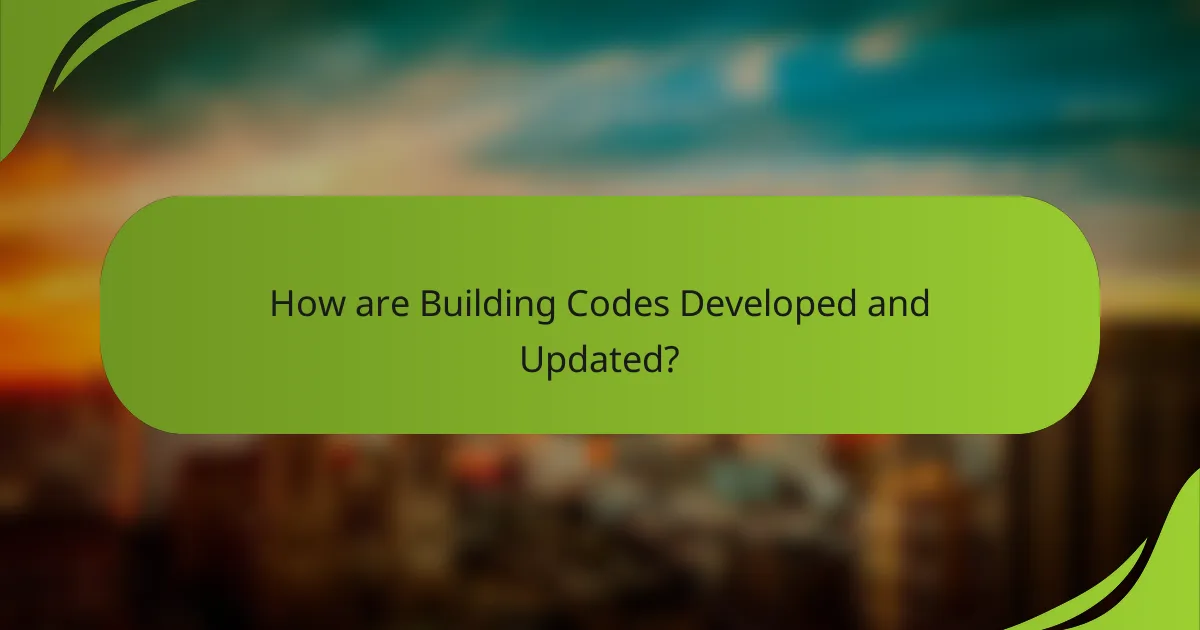Building codes are essential regulations that establish standards for construction and design to ensure safety, health, and welfare for occupants and the public. These codes cover critical areas such as structural integrity, fire safety, accessibility, and energy efficiency, and are enforced by local governments through inspections and permits. The International Code Council (ICC) plays a key role by providing model codes that are regularly updated to incorporate technological advancements and safety lessons. The article examines the systematic development and enforcement of building codes, highlighting the collaborative process involving various stakeholders, the importance of public input, and the impact of effective enforcement on reducing risks associated with building-related incidents.

What are Building Codes and Why are They Important?
Building codes are regulations that set standards for construction and design in buildings. They ensure safety, health, and general welfare for occupants and the public. Building codes address structural integrity, fire safety, accessibility, and energy efficiency. They are enforced by local governments to ensure compliance during construction. Non-compliance can lead to legal penalties and unsafe buildings. The International Code Council (ICC) provides model codes widely adopted across the U.S. These codes are updated regularly based on technological advancements and safety lessons learned. Their importance lies in protecting lives and property from hazards.
How do Building Codes ensure safety and compliance?
Building codes ensure safety and compliance by establishing minimum construction standards. These codes cover structural integrity, fire safety, electrical systems, and plumbing. They are designed to protect public health and safety. Compliance is enforced through inspections and permits. Authorities review plans before construction begins. Inspectors evaluate work at various stages. Non-compliance can result in fines or mandatory corrections. Historical data shows that adherence to building codes reduces accidents and fatalities. For instance, the National Institute of Standards and Technology found that proper code enforcement lowers fire-related injuries by up to 30%.
What specific safety standards are outlined in Building Codes?
Building codes outline specific safety standards to ensure structural integrity and occupant safety. These standards include requirements for fire safety, structural stability, and accessibility. Fire safety standards mandate the use of fire-resistant materials and the installation of smoke detectors. Structural stability standards dictate the load-bearing capacity of materials and the design of foundations. Accessibility standards ensure buildings are usable by individuals with disabilities. Additionally, codes cover electrical safety, plumbing safety, and energy efficiency. Compliance with these standards is enforced through inspections and permits. These regulations are based on national and local codes, such as the International Building Code (IBC).
How do Building Codes protect public health and welfare?
Building codes protect public health and welfare by establishing minimum safety standards for construction and occupancy. These codes ensure that buildings are structurally sound, reducing the risk of collapse. They mandate proper sanitation and waste disposal systems to prevent disease. Building codes also regulate fire safety measures to minimize hazards. They require adequate ventilation to ensure indoor air quality. Compliance with these codes helps prevent injuries and fatalities related to unsafe buildings. Historical data shows that regions with strict building codes experience fewer disasters and health issues. Overall, building codes play a crucial role in safeguarding the well-being of the community.
What are the consequences of not adhering to Building Codes?
Not adhering to building codes can lead to severe consequences. These include safety hazards for occupants and users. Buildings may become structurally unsound without proper compliance. This can result in injuries or fatalities during incidents like fires or earthquakes. Legal repercussions are also significant. Authorities may impose fines or require costly renovations. In some cases, non-compliant buildings may face demolition. Insurance claims can be denied if codes are violated. Overall, neglecting building codes compromises safety and legality.
What risks are associated with non-compliance?
Non-compliance with building codes poses significant risks. These risks include safety hazards for occupants. Structures may be unsafe, leading to potential injuries or fatalities. Non-compliance can also result in legal penalties for builders and property owners. Financial repercussions may arise from fines and increased insurance premiums. Additionally, non-compliant buildings may face difficulties in securing financing or selling. Local governments may impose mandatory repairs or demolitions on non-compliant structures. Overall, the risks associated with non-compliance can have severe implications for safety, finances, and legal standing.
How can non-compliance affect property value and insurance?
Non-compliance with building codes can significantly decrease property value and impact insurance coverage. Properties that do not meet safety standards are often viewed as less desirable. This perception can lead to lower market demand and reduced selling prices. Additionally, lenders may hesitate to finance non-compliant properties. Insurance companies may charge higher premiums or refuse coverage altogether for non-compliant structures. According to a study by the National Association of Insurance Commissioners, properties with code violations face increased risk assessments. This can lead to higher costs for homeowners and potential financial losses.

How are Building Codes Developed and Updated?
Building codes are developed and updated through a systematic process involving research, public input, and expert collaboration. Various stakeholders, including government agencies, industry professionals, and community members, contribute to the development process. Draft codes are typically based on existing regulations, safety standards, and technological advancements.
Public hearings allow for feedback and suggestions from the community. This input can lead to revisions and improvements in the proposed codes. Once finalized, building codes are adopted by local or state governments. Regular updates occur to reflect changes in technology, safety practices, and building materials.
For example, the International Code Council (ICC) updates the International Building Code every three years. This ensures that codes remain relevant and effective in promoting safety and compliance.
Who is involved in the creation of Building Codes?
Building codes are created by a combination of government agencies, industry professionals, and stakeholders. Local, state, and federal governments establish regulations to ensure safety and compliance. Architects and engineers contribute technical expertise during the drafting process. Construction industry representatives provide insights on practical applications. Public input is often sought to address community needs and concerns. Professional organizations may influence standards through advocacy and research. This collaborative approach ensures building codes are comprehensive and effective.
What role do government agencies play in establishing Building Codes?
Government agencies are crucial in establishing building codes. They develop regulations to ensure safety, health, and welfare in construction. Agencies assess risks and set standards based on research and best practices. They also collaborate with industry experts to draft comprehensive codes. Local, state, and federal agencies may have different codes, reflecting regional needs. Enforcement of these codes is vital for compliance in construction projects. Regular updates to codes ensure they address new technologies and materials. This process helps protect the public from unsafe structures and practices.
How do industry professionals contribute to Building Code development?
Industry professionals contribute to Building Code development by providing expertise and practical insights. They include architects, engineers, contractors, and safety officials. These professionals participate in code committees and public hearings. Their input helps ensure codes reflect current construction practices and technologies. For example, the International Code Council (ICC) relies on industry experts to draft and revise codes. Their contributions enhance safety, efficiency, and sustainability in building practices. This collaboration ultimately leads to more effective regulations that protect public health and safety.
What process is followed to update Building Codes?
The process to update building codes involves several key steps. First, local jurisdictions assess current codes and identify areas needing improvement. Next, stakeholders, including architects, builders, and engineers, provide input on proposed changes. Following this, a draft of the updated code is created. This draft undergoes public review and comment, allowing community feedback. After considering the feedback, revisions are made to the draft. Finally, the updated code is adopted through a formal voting process by the governing body. This systematic approach ensures that building codes remain relevant and effective in promoting safety and compliance.
How often are Building Codes reviewed and revised?
Building codes are typically reviewed and revised every three years. This periodic review allows for updates based on new technologies, materials, and safety practices. Various organizations, such as the International Code Council, lead these revisions. They gather input from industry professionals, stakeholders, and the public. The process ensures that building codes remain relevant and effective. Regular updates help to enhance public safety and compliance with modern standards.
What factors influence changes in Building Codes?
Changes in building codes are influenced by several key factors. These include advancements in construction technology, which introduce new materials and methods. Changes in safety standards also play a crucial role, as they reflect evolving understanding of risks. Environmental concerns drive updates to promote sustainability and energy efficiency. Legal requirements, such as new laws or regulations, necessitate code revisions. Public health issues, such as pandemics, can lead to changes in ventilation and sanitation standards. Economic factors, including market demands and cost considerations, influence the feasibility of implementing new codes. Lastly, feedback from construction professionals and the community can prompt revisions to improve practical application.

What is the Role of Enforcement in Building Codes?
Enforcement in building codes ensures compliance with safety standards. It involves inspections, permits, and penalties for non-compliance. Building officials conduct regular inspections to verify adherence to codes. These inspections help prevent unsafe construction practices. Permits are required before construction begins, ensuring plans meet code requirements. Penalties for violations promote accountability among builders and contractors. Effective enforcement reduces risks of structural failures and enhances public safety. Studies show that jurisdictions with strong enforcement have lower rates of building-related incidents.
How is compliance with Building Codes monitored?
Compliance with Building Codes is monitored through inspections and regulatory oversight. Building inspectors conduct regular site visits during construction. They verify that work meets local, state, and national codes. Documentation is reviewed to ensure compliance with design plans. Violations are reported and may lead to penalties or required modifications. Local building departments typically oversee this process. Their role ensures public safety and adherence to standards. Various jurisdictions may have specific monitoring practices. Regular updates and training for inspectors help maintain compliance accuracy.
What methods are used for inspections and enforcement?
Methods used for inspections and enforcement include on-site inspections, document reviews, and compliance audits. On-site inspections involve assessing construction sites for adherence to building codes. Inspectors check structural integrity, safety features, and materials used. Document reviews ensure that submitted plans and permits align with regulations. Compliance audits evaluate ongoing projects for code adherence. These methods help maintain safety standards and ensure legal compliance in construction practices.
How do penalties for non-compliance work?
Penalties for non-compliance with building codes typically involve fines and legal repercussions. Regulatory authorities enforce these penalties to ensure adherence to safety standards. Non-compliance can lead to monetary fines that vary based on the severity of the violation. In some cases, repeated violations may result in increased fines or additional sanctions. Authorities may also issue stop-work orders to halt construction until compliance is achieved. Legal action can be taken against persistent offenders, potentially resulting in court-mandated penalties. These measures aim to protect public safety and maintain the integrity of building standards.
What are the challenges faced in enforcing Building Codes?
Challenges in enforcing building codes include insufficient resources, lack of trained personnel, and inconsistent regulations. Local governments often struggle with limited budgets, which hampers their ability to conduct inspections. Additionally, many jurisdictions face a shortage of qualified inspectors, leading to delayed enforcement actions. Variability in building codes across regions creates confusion for builders and contractors. This inconsistency can result in non-compliance and safety risks. Public awareness of building codes is often low, which complicates enforcement efforts. Finally, political pressures can influence code enforcement priorities, affecting overall compliance.
How do local jurisdictions differ in their enforcement practices?
Local jurisdictions differ in their enforcement practices primarily due to variations in local laws and regulations. Each jurisdiction has its own set of building codes that dictate safety standards. Enforcement can vary based on resources allocated for inspections and compliance monitoring. Some jurisdictions may have more rigorous inspection schedules than others. Local political priorities also influence enforcement intensity. Historical incidents, such as natural disasters, can prompt stricter enforcement in certain areas. Additionally, community engagement levels can impact how enforcement is perceived and implemented. For instance, jurisdictions with active citizen involvement may enforce codes more stringently. These differences result in a patchwork of enforcement practices across regions.
What common obstacles do enforcement agencies encounter?
Enforcement agencies commonly encounter obstacles such as insufficient resources, lack of training, and public resistance. Insufficient resources limit the ability to conduct inspections and enforce compliance effectively. Lack of training can lead to inconsistent application of building codes. Public resistance often arises from misunderstandings about the purpose of regulations. Additionally, complex legal frameworks can hinder swift enforcement actions. These challenges can impede the overall effectiveness of enforcement efforts.
What best practices can ensure compliance with Building Codes?
To ensure compliance with building codes, it is essential to implement a systematic approach. First, familiarize yourself with local building codes and regulations. This knowledge forms the foundation for compliance. Next, conduct thorough planning and design reviews before construction begins. Engaging professionals like architects and engineers can help identify code requirements early.
Regular inspections during construction are crucial. These inspections verify that work aligns with approved plans and codes. Additionally, maintaining accurate documentation throughout the project is vital. This documentation serves as proof of compliance and can be referenced for future inspections.
Lastly, provide ongoing training for all personnel involved in construction. This ensures that everyone understands the importance of compliance and the latest code updates. Following these best practices significantly enhances the likelihood of meeting building code requirements.
How can builders and contractors stay updated on Building Code changes?
Builders and contractors can stay updated on Building Code changes by subscribing to industry newsletters and publications. These resources often provide timely updates on code revisions and interpretations. Participating in professional organizations also helps, as they frequently hold seminars and workshops on code changes. Additionally, attending local government meetings allows builders to hear directly about upcoming changes. Online platforms and forums dedicated to construction can also be valuable for real-time information sharing. Moreover, many jurisdictions publish code updates on their official websites, making it easy for contractors to access the latest information. Staying informed through these channels is essential for compliance and ensuring safety standards are met.
The main entity of the article is Building Codes, which are regulations that establish safety standards for construction and design in buildings. The article outlines the importance of building codes in ensuring safety, health, and public welfare, addressing aspects such as structural integrity, fire safety, and accessibility. It discusses the consequences of non-compliance, including legal penalties and risks to occupant safety, as well as the processes involved in the development, enforcement, and updating of these codes. Additionally, the article highlights the roles of government agencies and industry professionals in creating and enforcing building codes, along with best practices for compliance and staying informed about code changes.